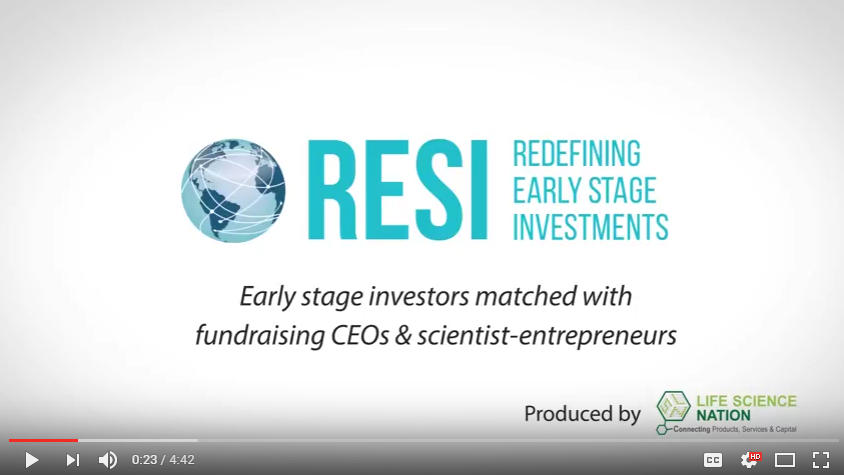By Dennis Ford, Founder & CEO, Life Science Nation; Creator of RESI Conference Series & RESI Healthtech Week
If you haven’t heard, Life Science Nation provides consulting services for branding and messaging, both critical to the fundraising process. The LSN mantra is, “We echo to our clients what the investors tell us they want to see”. Through conversations with investors through the years, LSN has the knowledge to help shape your marketing collateral to address what investors are looking for, whether you meet during a RESI Conference or on your own time.
Top Three Pieces of Marketing Collateral You Need
There are three key marketing documents investors generally evaluate to form a first impression of your company: the executive summary, pitch deck, and company website. These three pieces of content have one purpose: they serve to whet the target investor/partner’s appetite and convince them to request a meeting with you and start a dialogue. Below is a list of all supporting marketing collateral you may need for your fundraising campaign. This article will go into further detail on the executive summary, pitch deck, and website and what the content should highlight.
Marketing collateral every entrepreneur needs.
If you are looking for more detailed information on defining and developing your marketing collateral, please read Chapter 6 of Dennis Ford’s book, “The Life Science Executive’s Fundraising Manifesto“.
What “value” does your business add?
One key takeaway from all your marketing collateral should be the value of your company and its technology. Investors want to easily understand your message and value-add right away, no matter what the marketing collateral. Investors tend to be very busy, but if you can pique their initial interest, you will have plenty of opportunity to provide more information as the dialogue unfolds. The investor does not want to have difficulty understanding your company value so make sure you have a clear message for them.
There is no standardization.
Many of our clients go through a learning curve due to the lack of standardization of the fundraising collateral (executive summary etc.) required by investors. This makes it extremely difficult to provide a course on the basics of fundraising branding and messaging. This has led to the service we provide, creating custom marketing collateral.
An investor can receive as many as 100 solicitations per week. Investors have become experts at skimming and looking for a spark to ignite their interest. If that is not found, they quickly move on to the next opportunity.
How to get started.

An executive summary (ES) is typically no more than 2 pages and can be accompanied by a visual PowerPoint (your pitch deck) of 10-12 slides. Usually, they are sent together when you reach out for an initial introduction as it provides the investor with key background information upfront. The goal is to move them from either document to your website for more detailed content.
Here are five main points we have learned regarding the ES and pitch deck.
- Send both an executive summary and a pitch deck. Some folks click on an executive summary and others click on the deck. Most investors have an innate preference for one or the other. Since you won’t know before reaching out, LSN recommends that you send out both.
- The executive summary is the story of your company and how you got to your current state.
- The pitch deck should reflect what is in the executive summary, but in bullet form, with the addition of more information that shows the value-add of your firm and product.
- The pitch deck is your tool to present your company position to investors, therefore replacing your voice. It needs to stand completely on its own because it is read in your absence. Unlike a standard deck used for a presentation with bullets designed to trigger your dialogue, the pitch is being read as it is. The challenge is to be able to deliver the complete message with as few, concise words as possible and no need for a presenter.
- Remember, it’s the investor’s first introduction to your company. The investor will not have the full context, and therefore some level of contextual detail may be necessary.
Your website represents your company brand.
Your company website is a detailed representation explaining your company and its technology. It needs to offer a “deep dive” on the company and team, more detailed than is possible in your executive summary and pitch deck. The website should provide all of the detail and context that tell the full story of your company and its value. Even so, it is necessary to maintain consistency with your language and provide a clear message.
If done right and the message comes across, then the target partner will be able to assess that you’re a good fit and decide to initiate a conversation. The executive summary, the pitch deck and the website are all created for one reason – to give enough compelling information that an investor decides to initiate the first meeting.
Remember, it’s about the buyer: a busy investor with cash to allocate. Keep in mind they will do a quick scan of your deck and executive summary. They will be looking for something that will impart enough interest that they will want to have a chat with you and your firm.








Leave a comment